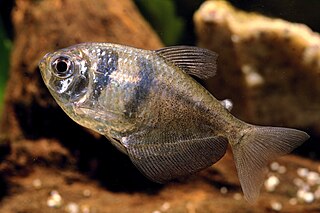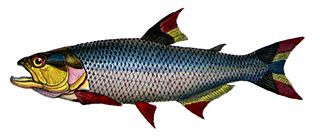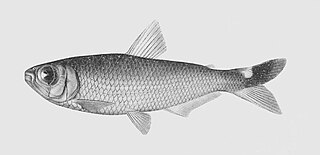
Characidae, the characids or characins is a family of freshwater subtropical and tropical fish, belonging to the order Characiformes. The name "characins" is the historical one, but scientists today tend to prefer "characids" to reflect their status as a by and large monophyletic group at family rank. To arrive there, this family has undergone much systematic and taxonomic change. Among those fishes that remain in the Characidae for the time being are the tetras, comprising the very similar genera Hemigrammus and Hyphessobrycon, as well as a few related forms such as the cave and neon tetras. Fish of this family are important as food and also include popular aquarium fish species.

The black tetra, also known as the black skirt tetra, petticoat tetra, high-fin black skirt tetra, black widow tetra and blackamoor, is a freshwater fish of the characin family (Characidae). It is native to the Paraguay River basin of south-central Brazil, Paraguay and northeast Argentina, but there are also populations in the upper Paraná and Paraíba do Sul Rivers that likely were introduced. It was formerly reported from the Guapore River, but this population is part of G. flaviolimai, which is found throughout the Madeira River basin and was described in 2015. The black tetra is often kept in aquariums.

Hyphessobrycon is a genus of freshwater fish in the family Characidae. These species are among the fishes known as tetras. The genus is distributed in the Neotropical realm from southern Mexico to Río de la Plata in Argentina. Many of these species are native to South America; about six species are from Central America and a single species, H. compressus is from southern Mexico.

Astyanax is a genus of freshwater fish in the family Characidae of the order Characiformes. Some of these fish, like many of their relatives, are kept as aquarium pets and known collectively as tetras. With around 150 described species and new ones being described yearly, this genus is among the largest of the entire order; Hyphessobrycon also has more than 145 species and which one is larger at any one time depends on whether more species have been recently described in one or the other. The blind and colorless cave tetra of Mexico is a famous member of the genus, but its taxonomic position is disputed: Some recognize it as part of the Mexican tetra and this is supported by phylogenetic evidence, but others recognize the cave form as a separate species, A. jordani.

Bryconops is a genus of freshwater fish in the family Iguanodectidae from South America. It consists of small fish, all under half-a-foot long, with slender bodies and silvery scales, though there is some mild color variation. Several species can be identified by way of a humeral patch, and others have a reddish ocellus, or eyespot, on one or both lobes of the dorsal fin.

Moenkhausia is a genus of freshwater fish in the family Characidae native to tropical and subtropical South America. These are medium-sized tetras where the largest species only reach around 12 cm (4.7 in).

Salminus, popularly known as dorado or dourado, is a genus of relatively large, predatory freshwater fish from the family Characidae. They are native to large tropical and subtropical rivers in South America, and undertake migrations during the rainy season to spawn. They are very popular among recreational anglers and also support important commercial fisheries.
Atopomesus pachyodus is a species of fish in the family Characidae endemic to the Rio Negro drainage, Amazon basin. This species is the only member of the genus Atopomesus.

Deuterodon is a genus of characins from river basins in southern and southeastern Brazil, with a single species of uncertain taxonomic status, D. potaroensis, from Guyana. These are small fish that reach up to 12.6 cm (5.0 in) in total length. They are omnivores with a specialized mouth structure that allows them to scrape algae and debris off bedrock.

Gymnocorymbus is a genus of small characins from the Amazon, Paraguay, Orinoco, Courantyne, Gurupí and Parnaíba river basins in South America. These tetras are popular in the aquarium trade.
Aphyodite grammica is a species of characin in the tribe Pristellini. It is found in parts of the Essequibo and Amazon River basins in Guyana.

Bryconops alburnoides is a small freshwater fish, approximately 6 inches long at its largest, that lives in the rivers of South America. It has a slender body, with a yellowish dorsal fin and yellow-tinged back scales that fade into silver on its belly. It is largely an insectivore that picks land-dwelling insects from the riverbanks, though it eats much more whenever rain washes prey into the water.

Bryconops giacopinii is a mid-sized species of freshwater fish in the family Iguanodectidae. It is the largest member of the genus Bryconops, and is therefore difficult to confuse with any of its congeners. With a diet that consists largely of land-dwelling insects, it serves as an important link between the terrestrial and aquatic aspects of its native range.

Bryconops gracilis is a small species of freshwater fish from the rivers of South America. It is one of multiple species for which the common name "lambari" is used. Though not well-studied, it has been re-described in recent years in order to differentiate it from Bryconops alburnoides, a congener to which it bears a strong resemblance.

Bryconops transitoria is a small freshwater fish that lives in the rivers of South America. It is a poorly-studied member of the genus Bryconops with few records and vague distribution accounts, though it is believed to be endemic to the Rio Tapajós. It was originally thought to be a subspecies of congener Bryconops melanurus, but is now accepted as its own species.
Bryconops vibex is a small freshwater fish from the rivers of Venezuela, known solely from the Rio Cataniapo. The body is slender, though with an element of sturdiness, and it has one humeral spot by each pectoral fin. It bears visual similarities to several congeners, but can be differentiated by way of many factors.
Iguanodectes polylepis is a species of freshwater fish from the rivers of South America. Its range is restricted to Brazil, where it inhabits the Madeira and Purus river basins. It is one of the larger members of the genus, but remains generally small, only a little over a quarter-foot long.

Astyanax bourgeti is a small species of freshwater fish native to the upper Amazon river in Brazil. Originally described in 1908, it is not a particularly well-studied member of the genus Astyanax, but there is enough information available to establish a native range, an appearance, and potential relationships to congeners; for example, A. bourgeti is a known member of the subgenus Poecilurichthys, and has been considered such for most of its existence. Biotope preferences, sympatry, diet, and behavior are all unknown.
The Mato Grosso astyanax(Astyanax apiaka) is a small freshwater fish endemic to the Apiacá river in Mato Grosso, Brazil. Its discovery is recent, as of 2023, which results in little published research of its natural behaviors or preferred biotopes. However, descriptions of its appearance and general environment have been solidified, as well as some baseline information regarding its diet. It lacks a conservation status from the IUCN.

Deuterodon oyakawai is a small species of characin endemic to a large river basin along the Atlantic coast in southeast Brazil. It was originally one of three members of the genus Probolodus, but Probolodus is now considered obsolete, synonymized with Deuterodon. Much like other members of Deuterodon, and like some species in related genera, D. oyakawai is a small, silvery fish with fins in some combination of red and clear. It has a defined humeral spot that can be used for identification.














